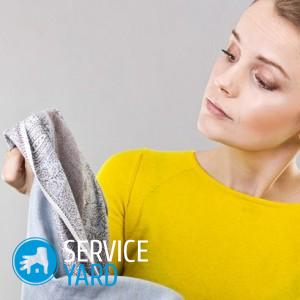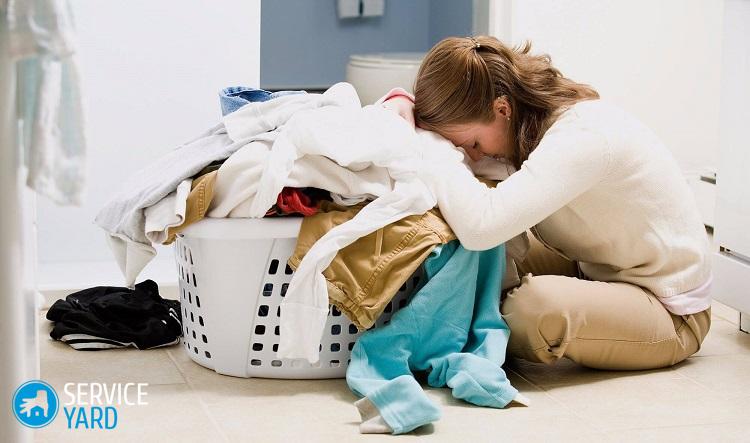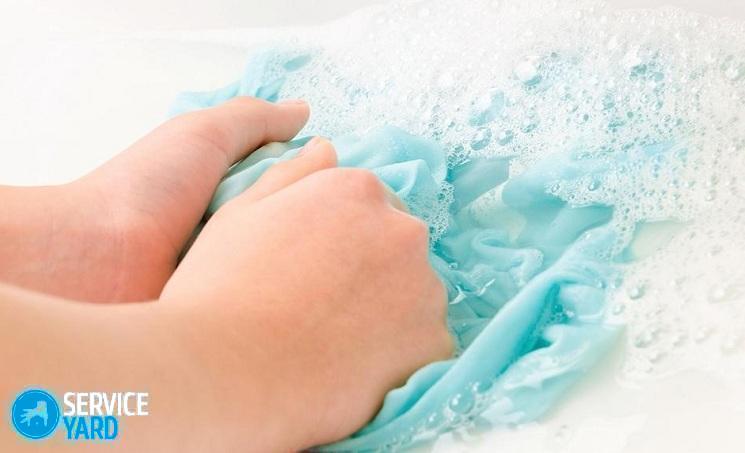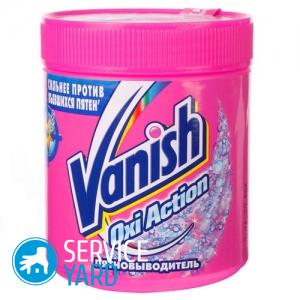How to remove stain on white 🥝 how to remove, remove old stains

The most unpleasant thing that can happen to your favorite thing is a spot that arose unexpectedly and in the most uncomfortable place. Unfortunately, a universal stain remover does not exist in nature, so every housewife needs to know how to remove old stains from clothes at home. So that you do not have to put beautiful things in a closet or even take them to the country because of one unpleasant spot, use our simple tips outlined in this article.
to contents ↑How to remove old stains from clothes - general tips
In order for the fight against spots on a white dress or any other clothing to be effective, you must adhere to the general rules:
- If possible, remove all contaminants from the fabric immediately, since a dried stain is much more difficult to remove. Most fresh stains can be removed with clean water. Rinse the problem area with cold first and then with hot water.
- Before treating contamination with a special tool, find out the nature of the origin of this spot. This will help you choose the most effective way to remove it.
- Pre-test the actions of chemicals on an inconspicuous part of the product (on the binder, on a spare piece of fabric, on stocks at the seams). If the tissue is not affected by the product, proceed to remove the stain.
- Do not use too concentrated chemical solutions. It is better to repeat the treatment of the tissue with a weak solution several times, alternating the procedure with washing the problem area.
- Before removing any stain, the thing must be cleaned from dust, first with a dry and then with a wet brush.
- Remove dirt from the wrong side by placing a sheet of blotting paper (paper towel) under the fabric.
- To remove stains, use cotton pads (swabs), a soft white cloth, or a soft brush. To prevent the blot from spreading, wipe the contaminated area from the edge to the middle.
- Do not use bleaches to remove stains on colored fabrics, as they can destroy paint.
- After removing the stain, be sure to wash the product in the usual way.
to contents ↑Important! Wash your products in accordance with the simple rules that we have collected in our individual reviews:
Correctly detect pollution
The origin of the spots is very different. You can just accidentally sit on a dirty bench, drop something on your favorite shirt (blouse) during work or feast, drop a piece of the cooked dish, etc. Conventionally, all spots can be divided into the following groups:
- Soluble in water. This category includes foods containing sugar, wood glue, water-soluble dyes.
- Soluble in organic products (gasoline, alcohol). The following contaminants fall into this category: grease, machine oil, varnish, resin, cream, shoe polish, wax, parquet mastic, oil paint.
- Insoluble in water and organic solvents. Contaminants of this type include: blood, pus, mold, urine, tannins, water-insoluble natural and artificial paints, protein substances, oxides of salts and metals.
To remove each type of stain, special treatment and special tools are needed. An important condition for a successful pollution control is the correct determination of its origin and material of the product.
Important! It should be remembered that aggressive drugs (vinegar and acetone) can not be used on nylon, acetate, polyvinyl chloride fibers, since they destroy them.
To correctly recognize the nature of the stain and wash it well, carefully consider its borders and color:
- Fat spots do not have pronounced boundaries. Contours of contamination are blurred or appear in the form of rays distributed in all directions. Old fat spots are lighter than fresh blots and most often appear even on the back of the material.
- Stains that do not contain fat (beer, tea, wine, fruit juice) have a sharp outline. The contour of contamination is darker than the spot itself. The color of the pollution varies from yellow to brown.
- Combined spots containing fatty and non-fatty substances (milk, blood, soup, sauce, coffee with milk, street dust) have more or less defined spots. It all depends on the fat content in the pollution. Such spots usually linger on the surface of the material, and the fat only penetrates deeper. These are the most common pollution.
- Oxidized spots have different edges. Depending on the time of formation, they turn yellow or redden, and some acquire a brown tint. Such spots appear on old impurities under the influence of light, oxygen and other factors. For example, stains from cosmetics, berries, fruits, tea, coffee, mold usually oxidize over time, and it is the most difficult to remove such problem areas.
Important! All of these contaminants are most often found in abundance on kitchen towels. It’s very difficult to remove each spot with a separate agent. Follow the link to find on our portal of useful tips all the information about how to wash kitchen towels at home without boiling.
Next, we will tell you how to remove old stains from clothes at home, depending on the nature of their origin.

Fat spots
Fatty contaminants are the most difficult to remove, since they penetrate deeply into the fibers of any tissue.
Important! The older the stain, the more effective and aggressive the remedy should be. In addition to their untidy appearance, such tissue sites have a persistent smell.
To get rid of the problem, use the following recommendations:
- To remove stains of fat from dense coarse tissues, use aggressive solvents: gasoline, white spirit, nail polish remover (acetone). Put a small amount of the product on the sponge and wipe the problem area.
- For delicate fabrics, use glycerin and ammonia. Preheat the glycerin to 40 degrees, apply to the stain and soak the problem area in water with ammonia.
- Dishwashing liquid can easily cope with grease stains on colored tissue. Apply the product on a cloth and it will dissolve the fat without damaging the color of the product.
- Wipe the greasy places on the collar of outerwear with a cotton swab dipped in a solution of sodium chloride and ammonia (10%). To prepare the solution, 5 g of salt per 25 g of ammonia is enough.
- Wipe old fatty blots with white soap diluted in gasoline in a proportion of 1:10. Leave the item for 1 hour, and then wash off the stain with gasoline.
- Light products from fatty blots will save a mixture of refined gasoline and potato flour (starch). Prepare the slurry from the ingredients and apply to the contamination. Wait for the mixture to dry, shake off the rest of the product. Rinse the treated area with clean water.

How to remove old sweat stains?
Most often, clothing suffers from sweat.Even observing all hygiene standards, using deodorants and other cosmetics, no one is safe from stubborn unpleasant yellow spots on everyday clothes that leave sweat stains.
Important! These contaminants contain inorganic salts (sulfates, salt, phosphates) and organic waste (acids, urea, fat, cholesterol). The acids contained in sweat stains damage the fibers of the fabric and decompose the dyes of the material. Regular washing of the product, unfortunately, does not always solve the problem, therefore, summer light clothes very often become unusable in one season.
To avoid this, you need to know how to remove the stain on white clothes at home in order to extend the life of your favorite things.
Important! In addition to sweat, deodorant stains remain on clothing. And subsequently, this “mixture” is very difficult to remove from clothing. Follow the link and find out about non-leaving deodorants.
We suggest you take advantage of folk wisdom and use the following recipes to combat pollution:
- Rub the sweat stain with laundry soap, leave the product for a while. Laundry soap has a whitening effect and does not harm even delicate fabrics. Rinse the fabric, if there are traces of sweat, then wipe them with strong saline. Salt removes dirt without destroying the fabric.
- To remove old sweat stains, add a little liquid ammonia to the water during washing (1 teaspoon of alcohol per 1 liter of water).
- If you do not know how to remove stains from a white shirt at home, then use hydrogen peroxide (an incomplete teaspoon of the product in a glass of water). Rinse the cleaned area with warm boiled water.
- For colored items, use vinegar (9%). Dilute 10 ml of vinegar in 80 ml of water, wipe the contaminated area with a solution. Rinse the fabric immediately after treatment, so that after prolonged exposure the solution does not cause a color change.
- Remove the oldest and most difficult sweat marks on the collars and folds of clothing with gasoline soap mixed with ammonia. Rub the compound with problem areas before washing the product.
Important! If you suffer from excessive sweating, you will be interested in our special publication. It is described in detail causes and methods of eliminating sweating.

How to remove old stains from clothes at home?
In addition to grease and sweat, our clothing is also subject to other pollution. The most common are stains from products, cosmetics, paints (inks), drinks (tea, coffee, juices, wine, beer, etc.). All pollution, of course, is better to clean immediately after the appearance, but if this did not happen, then we suggest that you familiarize yourself with effective folk remedies for old spots.
Here are just a few recommendations for removing old stains of various origins.
Dairy
Remove milky contaminants with a mixture containing 2 tablespoons of glycerin, 2 tablespoons of water and a few drops of ammonia. Treat the problem area with a solution, place it between two layers of white cotton cloth and iron with an iron.
Important! Soak colored wool contaminated with milk or ice cream, soak in glycerin, heated to 35 degrees. Leave the item for 10 minutes, then wash the treated area with soap and water and rinse in warm and then cold water.
Blood
Soak old blood stains in cold water (hot water leads to blood coagulation). After soaking, treat the area with a solution of ammonia (1 teaspoon per glass of water), and then with a solution of borax (1 teaspoon per glass of water).
Cosmetics
Remove traces of cosmetic cream or perfume with alcohol. Stains from hair dye should be treated with a mixture of hydrogen peroxide and ammonia, taken in equal proportions. A trace of lipstick is well removed by borax crystals. Fill the spot with brown, then rinse the fabric with soapy water and then with clean water.
Fruits and juices
Remove contamination from fruit juices with a mixture of vodka and glycerin, taken in equal proportions. Old spots will come off easier if you hold the fabric over steam and wipe them with vinegar or lemon juice, diluting the component in half with vodka. After treatment, wipe the cloth with a cotton pad dipped in a solution of water and ammonia.
Paint
After repair, old paint can only be removed with turpentine. However, along with the paint, the color of the fabric can also be removed, so before using the product, test it in an inconspicuous area. After the paint becomes soft under the influence of turpentine, remove it with a knife or brush. Wash the item after cleaning.
Grass
Herbal spots lend themselves perfectly to processing with alcohol (vodka) and sodium chloride solution.
Important! If the clothes are made of fabric that cannot be washed and processed, then entrust stains to professionals. Dry cleaning workers have extensive experience and have in their arsenal professional tools that can cope with any old and problem spots.
Alcohol
Remove traces of beer, champagne, wine with soap and baking soda. Since it is difficult to remove old wine stains the first time, use a mixture of glycerin and egg yolk in a 1: 1 ratio to combat them. Apply the mixture to the stain, and after a few hours, wash with soapy water and rinse in warm water.

Chocolate, tea and coffee:
- To remove the old trace of chocolate on white things, wipe it with hydrogen peroxide for 15 minutes.
- Stains from coffee and strong tea should be removed first with a brush dipped in warm water, and then washed in a warm soapy solution with ½ teaspoon added soda ash and 1 teaspoon of ammonia (per 1 liter of water). After processing, rinse the product first in warm, and then in cold water, slightly acidified with vinegar.
Mold
Remove traces of mold on cotton fabrics with chalk. Cover the problem area with dry, finely crushed chalk. Cover the stain on top with a paper towel or blotting paper and swipe the treated area with a hot iron. Carry out the cleaning procedure several times.
Important! The smell of dampness, mold and mustiness can be found even in the most modern housing. The reason for this phenomenon is excessive moisture, which contributes to the propagation of fungi. As soon as you feel an unpleasant smell coming from your closet, proceed to mold control.
Rust
It is quite difficult to remove rust, since with prolonged residence on the fabric, iron oxides destroy the fibers:
- Remove traces of rust with freshly squeezed lemon juice. Wet the stain with juice and iron it with a hot iron through a white, clean cloth. After that, wipe the stain again with cotton wool moistened with juice and rinse the treated area with warm water.
- Remove rusty marks from colored fabrics with a mixture of glycerin, soap and water, taken in equal proportions. Rub the mixture with dirt and leave the product for a day. After processing, wash and rinse the item.
Important! If you managed to remove stains from delicate fabrics without damaging them, then we hope you can not ruin your clothes while ironing. Our review will be your faithful assistant in this. "How to configure the ironing mode?".
Ink
Remove ink stains with glycerin. Keep the blot in glycerin for at least an hour, and then rinse the fabric in warm, slightly salted water. Remove any remaining marks with warm, soapy water.
Tanning:
- Moisten a trace of a hot iron on clothes with juice of onions and leave for several hours. Then wash the thing.
- If the contamination is large, then put onion gruel on it and leave for a while. After such processing, the item should be thoroughly rinsed in cold water.
- Remove white tan from the mixture with a mixture of 0.5 cups of water, 1 teaspoon of hydrogen peroxide and a few drops of ammonia.
to contents ↑Important! Use in the fight for clean laundry and stain removers for clothessold in household chemical stores. When buying a special product, pay attention to what materials the drug is intended for and with which spots it is able to cope. Before using the drug, be sure to read the instructions and follow all the manufacturer's recommendations exactly.
Stock footage
As you can see, there are many ways to get rid of unpleasant stubborn stains of any origin. You can use grandmother's secrets for this purpose, or you can use modern professional stain removers. All these tools are able to return things to their former purity, and besides, they do not take much time and energy. We hope that in our article you have found effective ways to remove any dirt, and now you know exactly how to remove stains from a white shirt. Take care of your favorite clothes and it will decorate your wardrobe for a long time!
- How to wash white things in a washing machine 🥝 How to remove clothes from gray
- How to Wash Shedding Things
- How to wash kitchen towels at home without boiling?
- Strong sweating in men 🥝 how to fight
- Non-leaving deodorant
- How to get rid of the smell of mold on clothes
- How to configure the ironing mode?
- Stain removers for clothes














